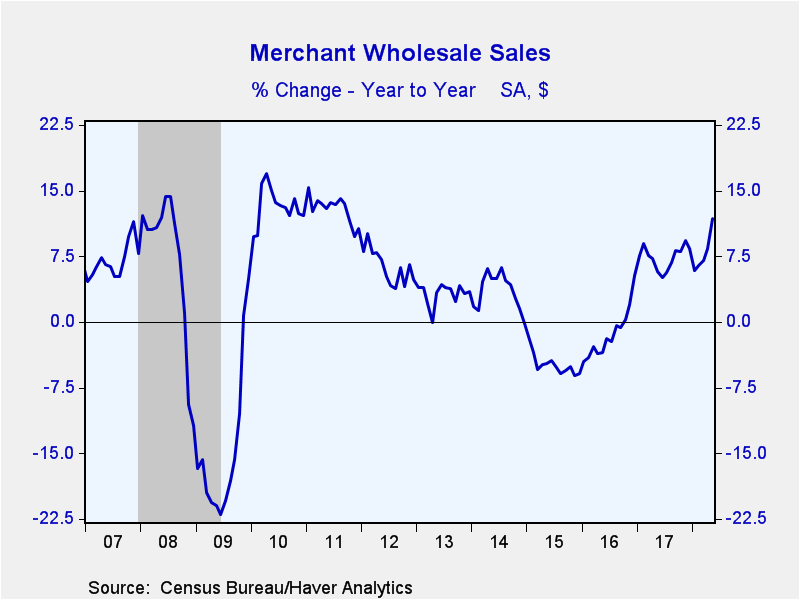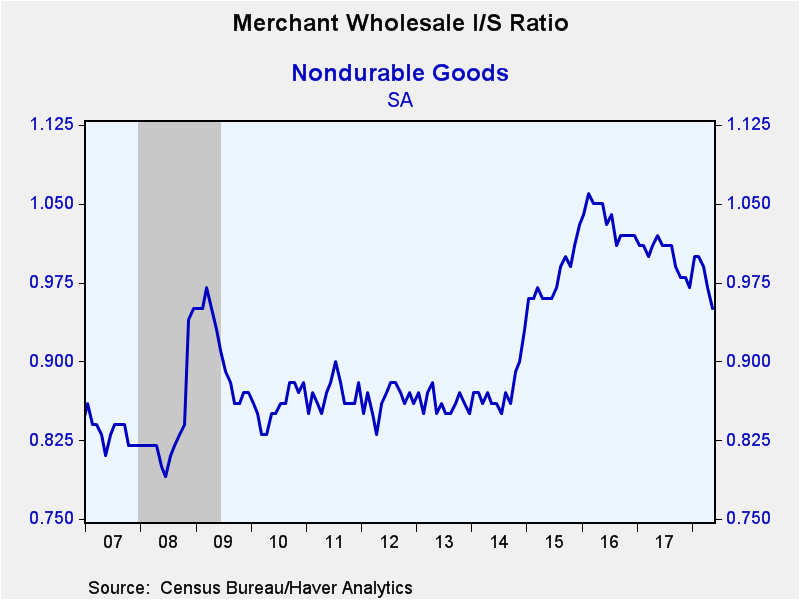 Global| Jul 11 2018
Global| Jul 11 2018U.S. Wholesale Inventories Rise; Sales Jump
Summary
Wholesale trade inventories grew 0.6% (5.9 year-on-year) in May following an unrevised 0.1% April gain. The May reading matched the increase reported in the advance report released on June 27 and compared to the 0.5% growth expected [...]
Wholesale trade inventories grew 0.6% (5.9 year-on-year) in May following an unrevised 0.1% April gain. The May reading matched the increase reported in the advance report released on June 27 and compared to the 0.5% growth expected by the Informa Global Markets Survey.
Durable goods inventories rose 0.5% (6.1% y/y) in May following a 0.2% rise in April. Machinery inventories, the largest sector, increased1.5% (6.9% y/y), while vehicles, the second largest, decreased 1.2% (+3.0% y/y). Electrical equipment grew 0.7% (8.2% y/y). Inventories of nondurable goods gained 0.7% (5.7% y/y) following an unchanged reading. Drug inventories, which make up a quarter of nondurable inventories, rebounded 2.1% (2.9% y/y) following a 2.2% drop in April. Groceries, the second largest category, edged up 0.2% (-0.1% y/y). Miscellaneous nondurables fell 0.6% (+4.3% y/y) the third consecutive monthly decline.
Sales at the wholesale level jumped 2.5% (11.8% y/y) in May following a 1.4% upwardly revised gain. A 0.6% May rise had been expected in the Action Economics Forecast Survey.
Durable goods sales increased 1.9% (10.5% y/y) after a 1.1% gain. Electrical equipment, the largest sector, rebounded 2.2% (8.6% y/y) more than reversing April’s 1.8% drop. Professional and commercial equipment, which includes computers, grew 2.4% (8.9% y/y), while vehicle sales climbed 2.9% (10.3% y/y). Nondurable product sales surged 3.1% (13.1% y/y) after a 1.6% rise. Petroleum product sales, the largest category, leapt 8.3% (51.8% y/y) fueled by a 6.4% (41.2% y/y) jump in oil prices. Drug sales grew 1.6% (6.9% y/y) while groceries edged up 0.1% (-3.2% y/y).
The inventory-to-sales (I/S) ratio at the wholesale level fell to 1.24 in May, the second consecutive monthly decline. This is the lowest level since November 2014.
The I/S ratio for durable goods decreased to 1.56 from 1.58, the lowest since September 2013. The machinery ratio was unchanged at its six year low of 2.57 while motor vehicles dropped to 1.55 from 1.62. The I/S ratio for nondurable goods declined to 0.95 the lowest since December 2014. The petroleum industry I/S ratio contracted to 0.39 also a three-and-a-half year low. The drug industry I/S edged up to 1.06.
The wholesale trade figures are available in Haver's USECON database. The expectations figure for inventories is contained in the MMSAMER database. Expectations for sales are from the AS1REPNA database.
| Wholesale Sector - NAICS Classification (%) | May | Apr | Mar | Y/Y | 2017 | 2016 | 2015 |
|---|---|---|---|---|---|---|---|
| Inventories | 0.6 | 0.1 | 0.2 | 5.9 | 3.6 | 2.2 | 1.3 |
| Sales | 2.5 | 1.4 | 0.4 | 11.8 | 7.4 | -1.3 | -4.9 |
| I/S Ratio | 1.24 | 1.27 | 1.29 | 1.31 (May '17) | 1.30 | 1.35 | 1.33 |
Gerald D. Cohen
AuthorMore in Author Profile »Gerald Cohen provides strategic vision and leadership of the translational economic research and policy initiatives at the Kenan Institute of Private Enterprise.
He has worked in both the public and private sectors focusing on the intersection between financial markets and economic fundamentals. He was a Senior Economist at Haver Analytics from January 2019 to February 2021. During the Obama Administration Gerald was Deputy Assistant Secretary for Macroeconomic Analysis at the U.S. Department of Treasury where he helped formulate and evaluate the impact of policy proposals on the U.S. economy. Prior to Treasury, he co-managed a global macro fund at Ziff Brothers Investments.
Gerald holds a bachelor’s of science from the Massachusetts Institute of Technology and a Ph.D. in Economics from Harvard University and is a contributing author to 30-Second Money as well as a co-author of Political Cycles and the Macroeconomy.









